
Sisteron is a commune in the Alpes-de-Haute-Provence department, Provence-Alpes-Côte d'Azur, southeastern France.

Castellane is a commune in the Alpes-de-Haute-Provence department in the Provence-Alpes-Côte d'Azur region in Southeastern France. With a population of 1,470 (2019), it has the distinction of being France's least populated subprefecture, ahead of Largentière in Ardèche.
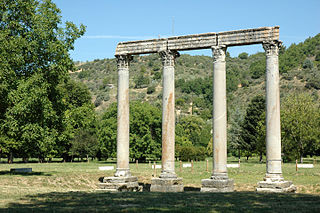
Riez is a hilly commune in the Alpes-de-Haute-Provence department in the Provence-Alpes-Côte d'Azur region in Southeastern France. It is located northwest of the Lac de Sainte-Croix, stemming from the Verdon, on the road to Valensole, at the confluence of the Auvestre and Colostre.
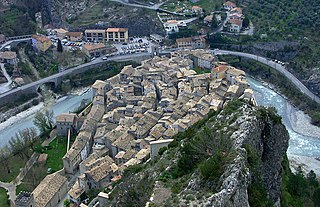
Entrevaux is a commune (municipality), former episcopal seat and Latin Catholic titular see in the Alpes-de-Haute-Provence department in southeastern France. It is a member of Les Plus Beaux Villages de France Association.
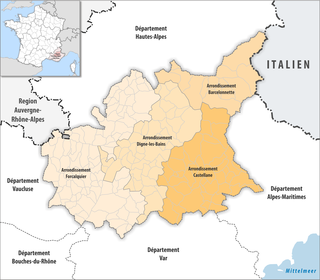
The 4 arrondissements of the Alpes-de-Haute-Provence department are:
- Arrondissement of Barcelonnette, with 14 communes. The population of the arrondissement was 7,874 in 2016.
- Arrondissement of Castellane, with 41 communes. The population of the arrondissement was 11,403 in 2016.
- Arrondissement of Digne-les-Bains, with 46 communes. The population of the arrondissement was 47,298 in 2016.
- Arrondissement of Forcalquier, with 97 communes. The population of the arrondissement was 95,990 in 2016.

The arrondissement of Digne-les-Bains is an arrondissement of France in the Alpes-de-Haute-Provence department in the Provence-Alpes-Côte d'Azur region. It has had 46 communes. Its population is 47,298 (2016), and its area is 1,574.0 km2 (607.7 sq mi).

The arrondissement of Forcalquier is an arrondissement of France in the Alpes-de-Haute-Provence department in the Provence-Alpes-Côte d'Azur region. It has 97 communes. Its population is 95,990 (2016), and its area is 2,605.4 km2 (1,006.0 sq mi).
The following is a list of the 15 cantons of the Alpes-de-Haute-Provence department, in France, following the French canton reorganisation which came into effect in March 2015:
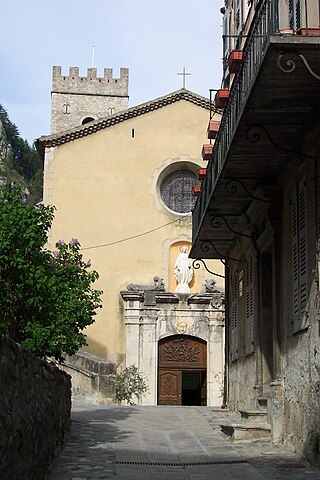
Glanate was a Gallo-Roman town on the right bank of the Var, which became the episcopal see of Glandève.

The Diocese of Digne is a Latin Church ecclesiastical territory or diocese of the Catholic Church in France. Erected in the 4th century as the Diocese of Digne, the diocese has been known as the Diocese of Digne–Riez–Sisteron since 1922. The diocese comprises the entire department of Alpes-de-Haute-Provence, in the Region of Provence-Alpes-Côte d'Azur. The diocese was a suffragan diocese of the Archdiocese of Aix-en-Provence and Arles until 2002 and is now a suffragan diocese in the ecclesiastical province of the metropolitan Archdiocese of Marseille. The Bishop of Digne's cathedra is found in Digne Cathedral at the episcopal see of Digne-les-Bains.

The former French diocese of Sisteron existed until the French Revolution. Its see was at Sisteron in southern France and at Forcalquier, in the modern department of Alpes-de-Haute-Provence. Sisteron was the only diocese in France which had two cathedrals. Each cathedral had a Chapter, and the two Chapters voted together when an election was held to elect a new bishop of Sisteron. The diocese of Sisteron was part of the ecclesiastical province of Narbonensis Secunda, whose Metropolitan was the Archbishop of Aix-en-Provence.

The Roman Catholic Archdiocese of Embrun was a Catholic jurisdiction located in southeastern France, in the mountains of the Maritime Alps, on a route that led from Gap by way of Briançon to Turin. It had as suffragans the Diocese of Digne, Diocese of Antibes and Grasse, Diocese of Vence, Diocese of Glandèves, Diocese of Senez and Diocese of Nice. Its see was the Cathedral of Nôtre Dame in Embrun.

Authon is a commune in the Alpes-de-Haute-Provence department in the Provence-Alpes-Côte d'Azur region of south-eastern France.

Aubignosc is a commune in the Alpes-de-Haute-Provence department in the Provence-Alpes-Côte d'Azur region of south-eastern France.
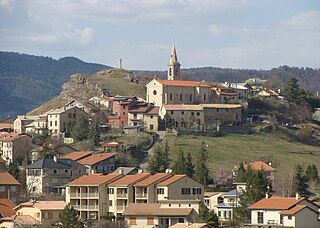
Turriers is a commune in the Alpes-de-Haute-Provence department in southeastern France.

Le Vernet is a commune in the Alpes-de-Haute-Provence department, and in the region of Provence-Alpes-Côte d'Azur, in southeastern France.

The canton of Riez is an administrative division in southeastern France. At the French canton reorganisation which came into effect in March 2015, the canton was expanded from 9 to 26 communes:

Alpes-de-Haute-Provence or sometimes abbreviated as AHP, formerly until 1970 known as Bas-Alpes, is a department in the Provence-Alpes-Côte d'Azur region of France, bordering Alpes-Maritimes and Italy to the east, Var to the south, Vaucluse to the west, Drôme and Hautes-Alpes to the north. Formerly part of the province of Provence, it had a population of 164,308 in 2019, which makes it the 8th least populated department and the 94th most populated French department.

The Notitia Galliarum is a Roman register of cities dating to the 4th–6th centuries AD. The Latin register is divided into two headings. Ten provinces are listed under the diocese of Gaul and seven under the diocese of the Seven Provinces. For each province the capital city is given and then its other cities (civitates). They are given their ethnic names, i.e., "city of [people]". A total of 115 cities are listed along with six or seven castra (forts) and one portus (harbour).






















